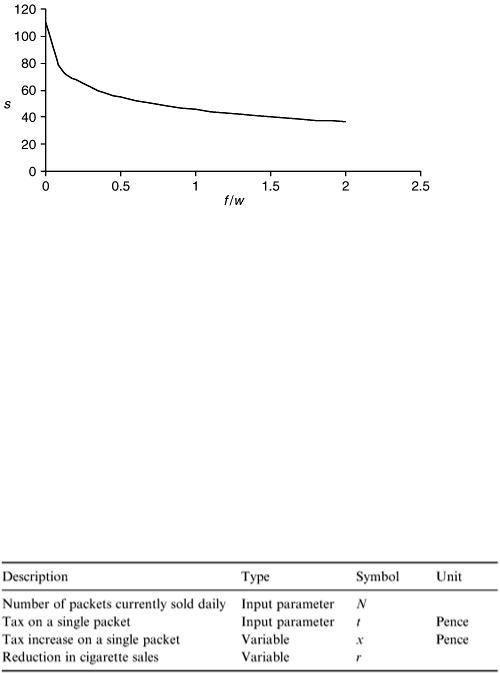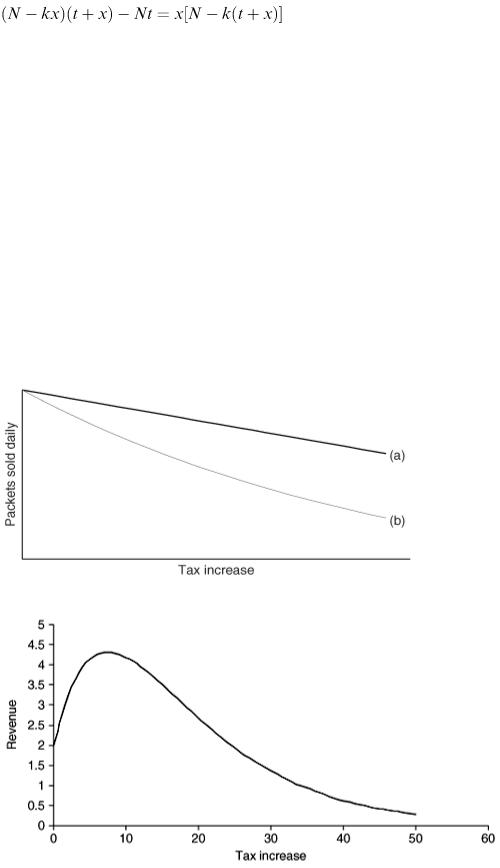
- •Preface
- •1.1 Introduction
- •1.2 Models and modelling
- •1.3 The learning process for mathematical modelling
- •Summary
- •Aims and objectives
- •2.1 Introduction
- •2.2 Examples
- •2.3 Further examples
- •Appendix 1
- •Appendix 2
- •Aims and objectives
- •3.1 Introduction
- •3.2 Definitions and terminology
- •3.3 Methodology and modelling flow chart
- •3.4 The methodology in practice
- •Background to the problem
- •Summary
- •Aims and objectives
- •4.1 Introduction
- •4.2 Listing factors
- •4.3 Making assumptions
- •4.4 Types of behaviour
- •4.5 Translating into mathematics
- •4.6 Choosing mathematical functions
- •Case 1
- •Case 2
- •Case 3
- •4.7 Relative sizes of terms
- •4.8 Units
- •4.9 Dimensions
- •4.10 Dimensional analysis
- •Summary
- •Aims and objectives
- •5.1 Introduction
- •5.2 First-order linear difference equations
- •5.3 Tending to a limit
- •5.4 More than one variable
- •5.5 Matrix models
- •5.6 Non-linear models and chaos
- •5.7 Using spreadsheets
- •Aims and objectives
- •6.1 Introduction
- •6.2 First order, one variable
- •6.3 Second order, one variable
- •6.4 Second order, two variables (uncoupled)
- •6.5 Simultaneous coupled differential equations
- •Summary
- •Aims and objectives
- •7.1 Introduction
- •7.2 Modelling random variables
- •7.3 Generating random numbers
- •7.4 Simulations
- •7.5 Using simulation models
- •7.6 Packages and simulation languages
- •Summary
- •Aims and objectives
- •8.1 Introduction
- •8.2 Data collection
- •8.3 Empirical models
- •8.4 Estimating parameters
- •8.5 Errors and accuracy
- •8.6 Testing models
- •Summary
- •Aims and objectives
- •9.1 Introduction
- •9.2 Driving speeds
- •Context
- •Problem statement
- •Formulate a mathematical model
- •Rewritten problem statement
- •Obtain the mathematical solution
- •9.3 Tax on cigarette smoking
- •Context
- •Problem statement
- •Formulate a mathematical model
- •Obtain the mathematical solution
- •9.4 Shopping trips
- •Context
- •Problem statement
- •Formulate a mathematical model
- •Obtain the mathematical solution
- •Interpret the mathematical solution
- •Using the model
- •9.5 Disk pressing
- •Context
- •Problem statement
- •Formulate a mathematical model
- •Obtain the mathematical solution
- •Interpret the mathematical solution
- •Further thoughts
- •9.6 Gutter
- •Context and problem statement
- •Formulate a mathematical model
- •Obtain the mathematical solution
- •9.7 Turf
- •Context
- •Problem statement
- •Formulate a mathematical model
- •Obtain the mathematical solution
- •Interpret the solution
- •9.8 Parachute jump
- •Context and problem statement
- •Formulate a mathematical model
- •Obtain the mathematical solution
- •9.9 On the buses
- •Context
- •Problem statement
- •Formulate a mathematical model
- •Obtain the mathematical solution
- •9.10 Further battles
- •Discrete deterministic model
- •Discrete stochastic model
- •Comparing the models
- •9.11 Snooker
- •Context
- •Problem statement
- •Formulate a mathematical model
- •Obtain the mathematical solution
- •Interpret the mathematical solution
- •9.12 Further models
- •Mileage
- •Heads or tails
- •Picture hanging
- •Motorway
- •Vehicle-merging delay at a junction
- •Family names
- •Estimating animal populations
- •Simulation of population growth
- •Needle crystals
- •Car parking
- •Overhead projector
- •Sheep farming
- •Aims and objectives
- •10.1 Introduction
- •10.2 Report writing
- •Preliminary
- •Main body
- •Appendices
- •Summary
- •General remarks
- •10.3 A specimen report
- •Contents
- •1 PRELIMINARY SECTIONS
- •1.1 Summary and conclusions
- •1.2 Glossary
- •2 MAIN SECTIONS
- •2.1 Problem statement
- •2.2 Assumptions
- •2.3 Individual testing
- •2.4 Single-stage procedure
- •2.5 Two-stage procedure
- •2.6 Results
- •2.7 Regular section procedures
- •2.8 Conclusions
- •3 APPENDICES
- •3.1 Possible extensions
- •3.2 Mathematical analysis
- •10.4 Presentation
- •Preparation
- •Giving the presentation
- •Bibliography
- •Solutions to Exercises
- •Chapter 2
- •Example 2.2 – Double wiper overlap problem
- •Chapter 4
- •Chapter 5
- •Chapter 6
- •Chapter 8
- •Index

Figure 9.2
9.3 Tax on cigarette smoking
Context
An increase in the level of tax on cigarettes will bring in extra tax revenue, however, it could lead to a reduction in the number of cigarettes sold, which could mean less revenue.
Problem statement
If the tax is increased by x pence per packet, what is the limit on the value of x if the increase is to be worthwhile from the point of view of the Chancellor of the Exchequer?
Formulate a mathematical model
Our list of factors is quite brief and is shown in Table 9.2.
Table 9.2
Assumptions
1 At present, N packets of cigarettes are sold every day and there is a tax t on each packet.
2(a) The reduction in the number of cigarettes smoked is proportional to the increase in price.
Obtain the mathematical solution
Using assumptions 1 and 2(a), before the tax rise we have N packets sold every day with a tax t on each. After the rise the tax on each packet changes to t + x
and the number of packets sold every day changes to N − kx where k is some constant (we are

assuming that the price rise is all tax). The difference in tax revenue every day is therefore
which will be positive if N > k ( t + x ). This is equivalent to the condition x < N / k − t. We could consider an alternative to assumption 2(a):
2(b) There is a constant percentage decrease in cigarette smoking for each penny rise in the price of a packet.
Using assumption 2(b) instead of 2(a), let r % be the percentage reduction. Note that this does not mean that if the tax is increased by, say 10 pence, the reduction will be 10 r %. The correct expression for the number of packets sold when the tax is increased by x pence is (1 − r /100) x N. The effects of the two assumptions 2(a) and 2(b) are compared in Figure 9.3, which shows how the number of packets sold daily decreases when the tax is increased. We note that for a certain level of increase x the assumption 2(a) predicts that the number of packets sold will become zero. This is probably less realistic than the gradual diminution predicted by model 2(b).
After the tax rise we now have (1 − r /100) x N packets sold daily with tax ( t + x ) on each so the net difference in the daily tax revenue is (1 − r /100) x N ( t + x ) − Nt = {(1 − r /100) x ( t + x ) − t } . This will be > 0 if (1 − r /100) x ( t + x ) > t. The graph of the function (1 − r /100) x ( t + x ) is shown in Figure 9.4. For the case r = 10, t = 2, it seems to indicate that x could go up to 25 before the net revenue drops.
Figure 9.3
